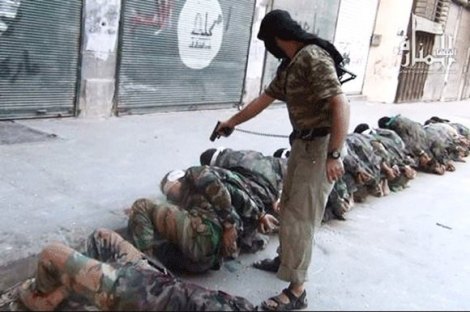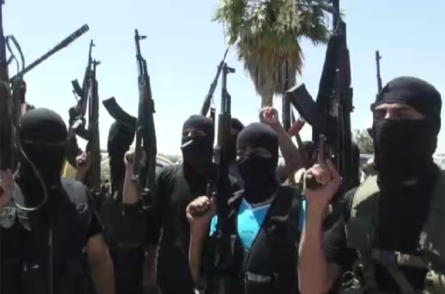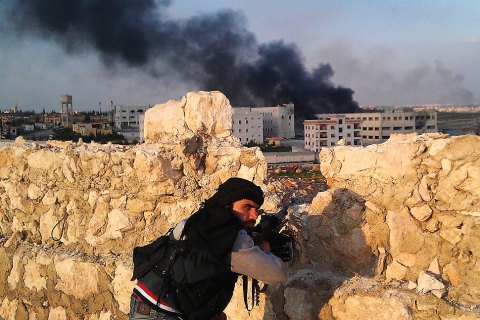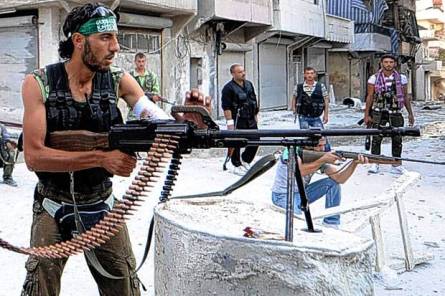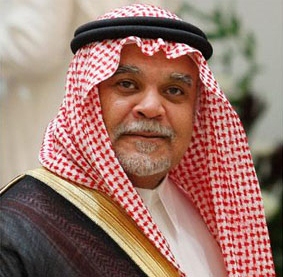Dr. George Friedman discusses the rise of a new regional power and the implications for other parts of the Middle East -- one of many changes the world will experience by 2020.
Showing posts with label middle east. Show all posts
Showing posts with label middle east. Show all posts
Saturday, 21 September 2013
The Decade Ahead: Changing Dynamics in the Middle East
Labels:Educate,Inspire,Change,Peace,Health,
economy,
Egypt,
israel,
middle east,
politics,
Syria,
Turkey
Thursday, 19 September 2013
Syrian Civil War: Inside the Armed Opposition
Recently tensions have been mounting between self-declared jihadists and Western-backed moderates fighting the Bashar al-Assad government in Syria. But who are these self-declared jihadists and how influential are they? How many factions or sub-groups make up the armed opposition? This article attempts to explain how complex the armed opposition in Syria really is.
When I began researching into the opposition my head began to spin. I found countless organizations and quickly realized how complex the situation really is. Tensions and hostilities are bound to arise when contrasting groups are trying to unite and fight together.
The main opposition group fighting in Syria is the Free Syrian Army (FSA) having an estimated 80,000 to 100,000 fighters. Composed of defected Syrian armed forces personnel and volunteers it is the most secular and moderate part of the opposition and has no political goals except the removal of the Bashar al-Assad government. Most FSA members are Sunni; the largest branch of Islam and Syria’s largest community.
The FSA mostly operate in the central region of Syria, Homs, Hama and the surrounding areas, but have elements operating nationwide. It has adopted guerrilla-style tactics against the government having declared it does not have the resources to occupy and take control of territories. It has very few heavy weapons and makes use of improvised explosive devices to attack military convoys of buses, trucks and tanks that are transporting supplies and security personnel.
Rebel fighter summarily executing prisoners
The FSA is internationally supported and are seen as the ‘good guys’. Sadly, a little research and you find out that the good guys are not so good. They have been accused of summarily executing prisoners, recruiting children as soldiers, kidnapping and executing pilgrims and a prominent Syrian actor, throwing civilians off rooftops and cutting organs from the bodies of dead prisoners.
Another group operating in Syria is the al-Nusra Front (ANF) or Jabhat al-Nusra. The ANF is an al-Qaeda associate and is designated a terrorist organization by the United Nations, the United States, Australia, and the United Kingdom. They have been described as “the most aggressive and successful arm of the rebel force” and as of early 2013, the ANF is estimated to have around 6,000 fighters. The ANF desires to create a Syria under Sharia law which alarms the more secular armed groups.
The FSA has consistently condemned the ANF´s use of suicide bombs during the war and indeed it appears that suicide bombings are their expertise. As of June 2013, the ANF had claimed responsibility for 57 of the 70 suicide attacks carried out since the beginning of the war.
al-Nusra Front Fighters
Strong words have been exchanged between the FSA and ANF for some time. The FSA accuses the ANF and others of “hijacking a revolution that began as an uprising to demand a democratic system”. According to the FSA their presence is reducing popular support for the opposition and many want the ANF to leave Syria. In December 2012 a leading FSA fighter made clear the way future events may unfold. “The next war after Bashar al-Assad falls will be between us and the Islamists”.
One group which probably has broader support among ordinary Syrians is the Syrian Islamic Front (SIF), with an estimated 25,000 fighters. The SIF declares its aims as toppling the Assad government and establishing an Islamic state. It opposes U.S. intervention against the regime and would consider such an intervention as new aggression against Muslims. Its largest group is the Salafist Ahrar al-Sham, which reportedly leads and dominates the Front.
As of late 2012, one of the strongest armed coalitions in Syria, representing up to half of Bashar al-Assad’s armed opponents, was the Syrian Islamic Liberation Front (SILF) estimated at having up to 40,000 fighters. The SILF overshadows the FSA in some regions and has some of the most important rebel units active in the war. The coalition obtains their weapons from attacks on the Syrian armed forces and from arms dealers but is also reportedly receives support from Turkey and Qatar. Again, the SILF much like the FSA has a minimalist political platform, promising to protect minorities and stating that religious Muslim law is the point of reference for the group.
Another group fighting in Syria is the Syrian Liberation Army (SLA); a loose coalition of localized forces, mostly composed of armed Syrian civilians who have joined the uprising. Based in Idlib Governorate, the SLA is primarily concerned with trying to expel government forces from the governorate. The SLA claims that over 70,000 youths are ready to join the group but are prevented from doing so due to lack of weaponry and equipment. Similarly to the FSA, the SLA concentrates on bombings and roadside explosions.
Having a little understanding of the groups involved helps understand recent developments.
Recently the al-Nusra Front (ANF) have said that they fear U.S. missile attacks against Syrian military installations would also target them, and that the West is seeking to use moderate rebel factions to keep them in check. In early September the ANF announced it would “go to war” against other rebel groups in in the Aleppo governorate.
Syrian Islamic Front fighter on the outskirt of Aleppo
Battles have taken place between rebel factions over the last few days.
On 14-September in the eastern province of Deir Ezzor, near the Iraqi border, deadly clashes erupted between the ANF and FSA.
On 18-September ANF fighters killed FSA members and took control of an area close to the Turkish border. Fighters from the Islamic State of Iraq and the Levant, an element of the ANF stormed the town of Azaz, 5km from the Syrian-Turkish border, and killed at least five FSA members, activists reported, adding 100 people were taken captive.
Allegations are also circulating that some rebel groups are collaborating with the Assad regime. The Ahfad al-Rasul Brigade, who operates independently, is such a group and has been accused of doing so by the ANF. Along with the allegation the ANF blew up the Ahfad al-Rasul headquarters and rounded up several of its members.
“You do not see ANF fighters in hotspots clashing with the regime. You see them trying to extend their control to areas we struggled hard to liberate” an Ahfad al-Rasoul fighter told Al Jazeera.
Recent developments have revealed major fractures are emerging within the armed opposition. Territorial disputes are taking place and threats are being made. The future of the struggle against the Bashar al-Assad government in Syria looks bleak.
Author: Martin Edwards
Originally posted on The Pianosa Chronicle
Labels:Educate,Inspire,Change,Peace,Health,
al-Nusra Front,
Free Syrian Army,
Human Rights,
Islam,
middle east,
news,
politics,
Syria,
syrian armed opposition,
war crimes
Location:
Buenos Aires, Argentina
Tuesday, 10 September 2013
Syrian Civil War: The use of chemical weapons in Syria
The 21-August chemical attack was not the first of its kind carried out since the beginning of the Syrian civil war which has been on-going since March, 2011. From a little online research I have found six other alleged uses of chemical weapons since December, 2012. The U.N. has also commented on the attacks and accused the Syrian opposition of using chemical weapons.
The first alleged use of chemical weapons was reported on 23-December, 2012. Six or seven people were allegedly killed, depending on which report you read, in Homs by a “poisonous gas” used by the Assad regime. The coverage included the report of side effects such as nausea, relaxed muscles, blurred vision, and breathing difficulties.
According to Dr. Abu al Fida, who treated about 30 of the approximately 100 people who were affected by the mysterious gas:
"It's still an apparent misuse, but the chemical was found to not be Sarin or the banned "Agent 15," despite showing clinical similarities to both.”
As a consequence of the attack, on 15-January a U.S. Department communication from the U.S. consul general in Istanbul said there was compelling evidence that the Syrian military had used a chemical weapon known as Agent 15. Agent 15 is similar to 3-quinuclidinyl benzilate or BZ, a powerful hallucinogen. While Syria is well-known to have a massive supply of chemical weapons, international observers haven’t ordinarily included BZ on the list.
Over the years, there have been rumors of BZ being used on a battlefield — including one that Iraqi insurgents dosed themselves with the drug to pump up their aggressiveness. If the 15-January communication is accurate, it would be the first confirmed case of BZ employed as a weapon.
A day later, 16-January, Tommy Vietor, a spokesman for the U.S. National Security Council, said that the alleged incident of chemical weapons use was not consistent with information that the White House has about Syria’s chemical weapons program.
On 19-March two more alleged uses of chemical weapons were reported in Syria’s two main cities of Aleppo and Damascus The attacks reportedly killed between 25 and 31 people and injured dozens more. The Assad regime claimed that Syrian opposition forces were responsible for the attacks and on 20-March requested the United Nations conduct an investigation.
Four days later on 24-March Syrian opposition activists reported that Syrian forces had used chemical weapons from multiple rocket launchers at the town of Adra, northeast of Damascus, reporting to have killed 2 people and wounding 23. Doctors described that the weapons used were phosphorus bombs that harm the nervous system and induce imbalance and loss of consciousness.
On 13-April the Syrian Observatory for Human Rights (SOHR) said that the Syrian army dropped two gas bombs on rebel-controlled Aleppo, killing 2 people and wounding 12. Opponents of the Syrian government accused the army of using chemical weapons.
Another attack allegedly took place on 29-April. A helicopter dropped canisters containing chemical weapons on the town of Saraqeb; 8 people claimed symptoms such as nausea and breathing problems, and one of them later died.
The world looks to the United Nations to verify the use of chemical weapons and on 5-May, 2012 it did.
Carla Del Ponte member of the Independent International Commission of Inquiry on the Syrian Arab Republic
"According to the testimonies we have gathered, the rebels have used chemical weapons, making use of sarin gas," del Ponte, a former war crimes prosecutor and member of the U.N. Independent International Commission of Inquiry on Syria, said in an interview with Swiss radio on 5-May.
"We still have to deepen our investigation, verify and confirm (the findings) through new witness testimony, but according to what we have established so far, it is at the moment opponents of the regime who are using sarin gas," she added.
Ms. del Ponte, a former Swiss prosecutor and attorney general, told Swiss TV: “Our investigators have been in neighboring countries interviewing victims, doctors and field hospitals. According to their report of last week, which I have seen, there are strong, concrete suspicions but not yet incontrovertible proof of the use of sarin gas, from the way the victims were treated.”
In response Rebel Free Syrian Army spokesman Louay Almokdad denied that rebels had used chemical weapons.
“In any case, we don’t have the mechanism to launch these kinds of weapons, which would need missiles that can carry chemical warheads, and we in the FSA do not possess these kind of capabilities,” Mr. Almokdad told CNN.
“More importantly, we do not aspire to have (chemical weapons) because we view our battle with the regime as a battle for the establishment of a free democratic state. … We want to build a free democratic state that recognizes and abides by all international accords and agreements — and chemical and biological warfare is something forbidden legally and internationally.”
As mentioned in my last article “Syrian Civil War: 21-August Chemical Attack” evidence exists that the Syrian opposition do have chemical weapons. If the U.S is waiting for a U.N analysis, one exists from back in May suspecting the opposition of using chemical weapons.
Article originally posted on The Pianosa Chronicle
Sources:
The Telegraph Article “UN accuses Syrian rebels of chemical weapons use”
The Washington Times Article “Syrian rebels used Sarin nerve gas, not Assad’s regime: U.N. official”
Independent International Commission of Inquiry on the Syrian Arab Republic
Labels:Educate,Inspire,Change,Peace,Health,
Chemical Attack,
Chemical Weapons,
controversy,
injustice,
middle east,
Sarin,
Syria,
U.N.
Location:
Buenos Aires, Argentina
Monday, 9 September 2013
Syrian Civil War: 21-August Chemical Attack
On 21-August Syrian activists reported that Assad forces struck Jobar, Zamalka, ‘Ain Tirma, and Hazzah in the Eastern Ghouta region with chemical weapons. As a result on 30-August the US government released a four-page document, link provided, outlining their conclusions about the August 21 attack, blaming Assad and stating that 1,429 people had been killed including 426 children.
Their assessment was based on human, signals, and geospatial intelligence as well as a significant body of open-source reporting.
“We assess with high confidence that the Syrian government carried out the chemical weapons attack against opposition elements in the Damascus suburbs on August 21. We assess that the scenario in which the opposition executed the attack on August 21 is highly unlikely. The body of information used to make this assessment includes intelligence pertaining to the regime’s preparations for this attack and its means of delivery, multiple streams of intelligence about the attack itself and its effect, our post-attack observations, and the differences between the capabilities of the regime and the opposition.”
“The Syrian regime has the types of munitions that we assess were used to carry out the attack on August 21, and has the ability to strike simultaneously in multiple locations. We have seen no indication that the opposition has carried out a large-scale, coordinated rocket and artillery attack like the one that occurred on August 21.”
To summarize, the US government blames the Syrian government, in part, because they believe the opposition does not have the means to carry out such an attack.
With little effort claims that the opposition does indeed have the capabilities to carry out chemical weapons attacks can be found online.
Syrian Rebels On The Streets Of Aleppo
An article published by Mint Press News, on 31-August, written by Dale Gavlak and Yahya Ababneh, claims that Syrian rebels have been given chemical weapons by the Saudis and reports that Syrians on the ground in Gouta and Damascus report chemical weapons were used by the rebels.
According to the article, numerous interviews with doctors, Ghouta residents, rebel fighters and their families, reveal that many believe that certain rebels received chemical weapons via Saudi intelligence and were responsible for carrying out the 21-August gas attack.
A female rebel fighter reportedly complained, “They didn’t tell us what these arms were or how to use them, we didn’t know they were chemical weapons. We never imagined they were chemical weapons.”
A well-known rebel leader in Ghouta reportedly said “Jabhat al-Nusra militants do not cooperate with other rebels, except with fighting on the ground. They do not share secret information. They merely used some ordinary rebels to carry and operate this material. We were very curious about these arms.”
Rebels and local residents in Ghouta accuse Saudi intelligence chief, Prince Bandar bin Sultan of providing chemical weapons to Jabhat al-Nusra; an al-Qaida linked rebel group.
In a recent article for Business Insider, reporter Geoffrey Ingersoll highlighted Saudi Prince Bandar’s role in the two-and-a-half year Syrian civil war. Many observers believe Bandar, with his close ties to Washington, has been at the very heart of the push for war by the U.S. against Assad. Ingersoll refers to an article in the U.K.’s Daily Telegraph newspaper about secret Russian-Saudi talks alleging that Bandar offered Russian President Vladimir Putin cheap oil in exchange for dumping Assad.
Prince Bandar bin Sultan: Saudi Intelligence Chief
“Prince Bandar pledged to safeguard Russia’s naval base in Syria if the Assad regime is toppled, but he also hinted at Chechen terrorist attacks on Russia’s Winter Olympics in Sochi if there is no accord,” Ingersoll wrote.
“I can give you a guarantee to protect the Winter Olympics next year. The Chechen groups that threaten the security of the games are controlled by us,” Bandar allegedly told the Russians.
Prince Bandar is reported to have urged the U.S. to arm and train rebels out of a planned military base in Jordan. Rebels interviewed said Prince Bandar is referred to as “al-Habib” or ‘the lover’ by al-Qaida militants fighting in Syria.
To conclude this article I would like to talk about motives for the 21-August chemical attack. Who wins from the attack? Answer: the Syrian opposition. Since 21-August the U.S, the U.K, France and others have been calling for military intervention. The Syrian rebels are not winning the civil war but now have some new and powerful international friends.
Over the next few days more articles will be posted on other aspects of the Syrian civil war and more on what the mainstream media is not reporting.
Websites:
U.S. Government Assessment of the Syrian Government’s Use of Chemical Weapons on August 21, 2013
Mint Press News Article “Syrians In Ghouta Claim Saudi-Supplied Rebels Behind Chemical Attack”
Business Insider Article “The Saudis Offered Mafia-Style ‘Protection’ Against Terrorist Attacks At Sochi Olympics”
Article originally posted on The Pianosa Chronicle
Labels:Educate,Inspire,Change,Peace,Health,
Chemical Attack,
controversy,
Human Rights,
injustice,
Jabhat al-Nusra,
middle east,
news,
Sarin,
Syria
Location:
Buenos Aires, Argentina
Subscribe to:
Posts (Atom)


